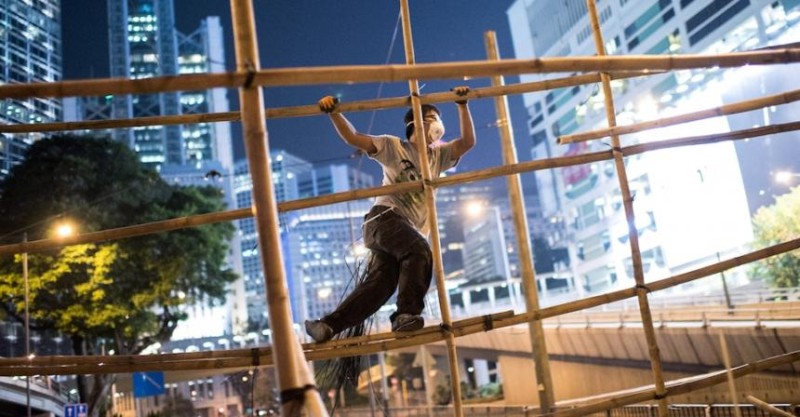Hong Kong Protesters Are Digging In
Pro-democracy demonstrators are fortifying barricades with wood, bamboo, even cement.
By Suzanne Sataline
October 13, 2014
Foreign Policy

Outside of the Admiralty subway station in downtown Hong Kong, about 30 young people sat on the pavement near a large and dusty pile of plaster, plasterboard, and wood, which someone had scrounged from an office renovation nearby. Wearing cotton gloves and safety masks, the young men and women pulled nails from thin slats. Some used bricks to nudge the iron from the wood. The dust rose and the sound glanced off steel beams overhead. The building of new barricades had begun.
Pro-democracy protesters who call themselves the “umbrella movement” took some hard blows on Oct. 13. Two weeks after commandeering a highway and part of three shopping districts, bringing a good deal of commerce and traffic in Hong Kong to a halt, student leaders offered a deal to the city. They would allow cars into the Admiralty area in downtown Hong Kong if the city would let protesters meet in Civic Square, near the government headquarters.
Instead, the city continued to insist that the protesters, who are demanding universal suffrage in the Chinese territory and the ouster of the city’s head of government, C.Y. Leung, were breaking the law. Police arrived at Admiralty early on the morning of Oct. 13, cutting plastic ties and removing metal police barriers that students had strung together. Hours later, dozens of thugs arrived and started pushing the metal gates, as well as some protesters. Area office workers watched from nearby bridges, some filming the melee. A crane rolled to the scene and scooped up metal barriers.
But far from being cowed, students soon began re-building their barricades out of anything else they could find.
Instead of abandoning their posts, protesters are once again digging in.
With the nails removed, the youth piled the wood onto a handcart. Two young men wheeled it past a new barricade — one with pieces of wood interlaced with metal and large swaths of beige carpet fastened over the contraption. The men zoomed out to Queensway, a wide road where a crowd of about 200 had gathered. A trellis of bamboo scaffolding jutted skyward, rising from a heap of metal and plastic street barriers topped with wood slats and metal rods, knotted with plastic wrap, steel wire, and bundles of plastic ties. The bamboo rods reached higher than a nearby pedestrian bridge, the ends sawed off to make them sharp. Every head was tipped upward, toward two men who balanced on bamboo scaffolding while knotting a series of plastic ties.
The crowd burst into applause. “This is Hong Kong! They will never beat us!” cried Chris Wong, 26, a healthcare worker. A New Yorker in his 20s named Joe stepped up to the barrier, narrating the scene into his cell phone pressed to his ear. “It’s like Les Mis,” he told the caller.
Innana Chow jumped deftly from a horizontal bamboo pole to the street. A compact man with cat-like grace, he was one of five scaffolding workers there Monday night, none of whom knew the others. But he said they had similar goals. “I want to build something to protect the students,” said Chow, who is 25.
At the base, a team of about 30 construction workers — deeply tanned, with long, lithe muscles — re-checked the plastic ties at the barricade’s base. They don’t work together, but all are friends on Facebook in a group started by construction worker Kruzo Cheuck as a way to socialize. Cheuck said the workers didn’t like that their trade association leaders had blamed the student movement for a recent lack of work. Construction jobs had slowed, and 2,000 workers have been idle, through no fault of the protesters, he said. “We came because we think we are being used,” said worker Manson Lau.
Instead, the workers taught the youth how most anything could be used to block vehicles and protect their turf. Metal bars were joined with chains or wads of twist ties slathered in glue and swaddled in plastic wrap — to make it impossible for the police to simply cut them free. Bamboo poles, brought by the workers, were in abundance. At one barricade, about 20 rods affixed to the metal barriers jut straight out like swords. The ends were sheathed in plastic wrap or bottles, to prevent passersby from injury.
When the crew ran short of metal structures at the east end of Queensway, a central tram route, the team created a matrix of bamboo rods that threaded through trash bins. Wet cement affixed the contraption to the pavement. About 150 feet away, eight police officers stood watching. “We should get the ‘Occupy Best Design of the Year’ award,” exclaimed Max Lee, a 28-year-old environmental consultant. “I don’t think a tank can get in,” said friend Desmond Wai, 30, an assistant manager at a fashion company.
Around one o’clock in the morning, a crew of young workers readied their final barrier of the night — wall after wall of bamboo, metal, and plastic and wood pallets. Workers had dragged large planters from elsewhere to the inside of the maze.
I asked a young man with a skull and bones neckerchief over his mouth if he knew the designer. “I’m pretty sure it’s me,” said Jason Yim. The 23-year-old sound engineer said he was in Mong Kok on Oct. 5 when crowds who opposed the democracy protesters beat up student occupiers in the busy shopping district, leading to 19 arrests. Police said eight suspects had links to the city’s triad underworld. The occupiers, some who sleep at the sites all night, needed to ensure the gangs wouldn’t return.
Thinking of how to shore up roadblocks, Yim recalled a favorite childhood pastime. “I said, ‘why don’t we put it together like Legos?'” Most of the barricades have held in Mong Kok and they will hold in Admiralty, he said — should the government, the police, or the triads return. “I’m pretty sure it’s wisely designed.”
